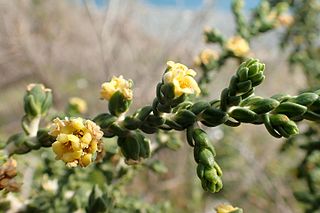
The Malvales are an order of flowering plants. As circumscribed by APG II-system, the order includes about 6000 species within 9 families. The order is placed in the eurosids II, which are part of the eudicots.
Theales is a botanical name at the rank of order. Early classifications such as that of Dahlgren placed the Theales in the superorder Theiflorae. The name was used by the Cronquist system for an order placed in subclass Dilleniidae, in the 1981 version of the system the circumscription was:

The Afrotropical realm is one of Earth's eight biogeographic realms. It includes Africa south of the Sahara Desert, the majority of the Arabian Peninsula, the island of Madagascar, southern Iran and extreme southwestern Pakistan, and the islands of the western Indian Ocean. It was formerly known as the Ethiopian Zone or Ethiopian Region.
The Cronquist system is a taxonomic classification system of flowering plants. It was developed by Arthur Cronquist in a series of monographs and texts, including The Evolution and Classification of Flowering Plants and An Integrated System of Classification of Flowering Plants (1981).

The Thymelaeaceae are a cosmopolitan family of flowering plants composed of 50 genera and 898 species. It was established in 1789 by Antoine Laurent de Jussieu. The Thymelaeaceae are mostly trees and shrubs, with a few vines and herbaceous plants.
A system of plant taxonomy, the Goldberg system was published in:
The Melchior system, "a reference in all taxonomic courses", is a classification system detailing the taxonomic system of the Angiospermae according to A. Engler's Syllabus der Pflanzenfamilien (1964), also known as "modified or updated" Engler system.
Dialyceras coriaceum is a tree in the family Sphaerosepalaceae. It is endemic to Madagascar.
Dialyceras is a genus of trees in the family Sphaerosepalaceae. The species are all endemic to Madagascar.
Dialyceras discolor is a tree in the family Sphaerosepalaceae. It is endemic to Madagascar.
Rhopalocarpus alternifolius is a tree in the family Sphaerosepalaceae. It is endemic to Madagascar.
Rhopalocarpus is a genus of plants in the family Sphaerosepalaceae. Most species are trees and all are endemic to Madagascar. The generic name is from the Greek meaning "club fruit", referring to the fruit shape.
Rhopalocarpus mollis is a tree in the family Sphaerosepalaceae. It is endemic to Madagascar. The specific epithet mollis is from the Latin meaning "soft", referring to the very soft indumentum on the leaves' underside.
Rhopalocarpus randrianaivoi is a tree in the family Sphaerosepalaceae. It is endemic to Madagascar. It is named for the authors' colleague and specimen collector Richard Randrianaivo.
Rhopalocarpus coriaceus is a tree in the family Sphaerosepalaceae. It is endemic to Madagascar.
Rhopalocarpus louvelii is a tree in the family Sphaerosepalaceae. It is endemic to Madagascar.
Rhopalocarpus lucidus is a tree in the family Sphaerosepalaceae. It is endemic to Madagascar.
Rhopalocarpus macrorhamnifolius is a tree in the family Sphaerosepalaceae. It is endemic to Madagascar.
Rhopalocarpus similis is a tree in the family Sphaerosepalaceae. It is endemic to Madagascar.

Octolepidoideae is a subfamily and one of the earliest branches of the Thymelaeaceae family. This species inherited multiple morphological character states from its ancestor, Thymelaeaceae. The calyx of a typical octolepidoideae is 5-merous. Researchers have found the species to contain 4-merous and 6-merous calyces, albeit they remain rarer.



